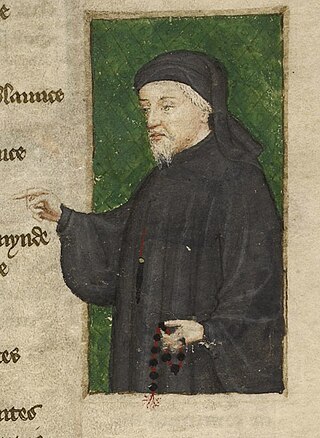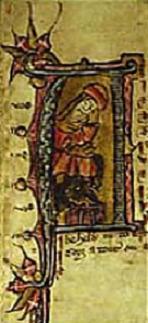Related Research Articles

The Canterbury Tales is a collection of twenty-four stories that runs to over 17,000 lines written in Middle English by Geoffrey Chaucer between 1387 and 1400. It is widely regarded as Chaucer's magnum opus. The tales are presented as part of a story-telling contest by a group of pilgrims as they travel together from London to Canterbury to visit the shrine of Saint Thomas Becket at Canterbury Cathedral. The prize for this contest is a free meal at the Tabard Inn at Southwark on their return.

Geoffrey Chaucer was an English poet, author, and civil servant best known for The Canterbury Tales. He has been called the "father of English literature", or, alternatively, the "father of English poetry". He was the first writer to be buried in what has since come to be called Poets' Corner, in Westminster Abbey. Chaucer also gained fame as a philosopher and astronomer, composing the scientific A Treatise on the Astrolabe for his 10-year-old son Lewis. He maintained a career in the civil service as a bureaucrat, courtier, diplomat, and member of parliament.

Piers Plowman or Visio Willelmi de Petro Ploughman is a Middle English allegorical narrative poem by William Langland. It is written in un-rhymed, alliterative verse divided into sections called passus.
This article contains information about the literary events and publications of 14th century.

William Langland is the presumed author of a work of Middle English alliterative verse generally known as Piers Plowman, an allegory with a complex variety of religious themes. The poem translated the language and concepts of the cloister into symbols and images that could be understood by a layman.

The Ellesmere Chaucer, or Ellesmere Manuscript of the Canterbury Tales, is an early 15th-century illuminated manuscript of Geoffrey Chaucer's Canterbury Tales, owned by the Huntington Library, in San Marino, California. It is considered one of the most significant copies of the Tales.
The Hengwrt Chaucer manuscript is an early-15th-century manuscript of the Canterbury Tales, held in the National Library of Wales, in Aberystwyth. It is an important source for Chaucer's text, and was possibly written by someone with access to an original authorial holograph, now lost.

Walter William Skeat, was a British philologist and Anglican deacon. The pre-eminent British philologist of his time, he was instrumental in developing the English language as a higher education subject in the United Kingdom.

Thomas Hoccleve or Occleve (1368/69–1426) was a key figure in 15th-century Middle English literature, significant for promoting Chaucer as "the father of English literature", and as a poet in his own right. His poetry, especially his longest work, the didactic work Regement of Princes, was extremely popular in the fifteenth century, but went largely ignored until the late twentieth century, when it was re-examined by scholars, particularly John Burrow. Today he is most well known for his Series, which includes the earliest autobiographical description of mental illness in English, and for his extensive scribal activity. Three holographs of his poetry have survived, and he also copied literary manuscripts by other writers. As a clerk of the Office of the Privy Seal, he wrote hundreds of documents in French and Latin.
Pierce the Ploughman's Crede is a medieval alliterative poem of 855 lines, lampooning the four orders of friars.
There are two pseudo-Chaucerian texts called "The Plowman's Tale".
The Piers Plowman tradition is made up of about 14 different poetic and prose works from about the time of John Ball and the Peasants Revolt of 1381 through the reign of Elizabeth I and beyond. All the works feature one or more characters, typically Piers, from William Langland's poem Piers Plowman. Because the Plowman appears in the General Prologue to The Canterbury Tales by Geoffrey Chaucer but does not have his own tale, plowman tales are sometimes used as additions to The Canterbury Tales, or otherwise conflated or associated with Chaucer.
Harley MS 7334, sometimes known as the Harley Manuscript, is a mediaeval manuscript of Chaucer's Canterbury Tales held in the Harleian Collection of the British Library.
The Trinity Gower D Scribe, often referred to simply as Scribe D, was a professional scribe and copyist of literary manuscripts active during the late fourteenth and early fifteenth century in London, England. Although his real name long remained unknown, Scribe D has been described as "so well known to students of late Middle English manuscripts that he hardly needs any introduction".
Johannes August Hermann (John) Koch was one of the most prolific modern scholars of medieval English literature, especially the works of Geoffrey Chaucer.
The Canterbury Tales is a collection of stories, mostly in verse, written by Geoffrey Chaucer chiefly from 1387 to 1400. They are held together in a frame story of a pilgrimage on which each member of the group is to tell two tales on the way to Canterbury, and two on the way back. Fewer than a quarter of the projected tales were completed before Chaucer's death. It is uncertain in what order Chaucer intended the tales to appear; moreover it is very possible that, as a work-in-progress, no final authorial order of tales ever existed.
Sebastian Sobecki is a medievalist specialising in English literature, history, and manuscript studies.
Norman Francis Blake was a British academic and scholar specialising in Middle English and Early Modern English language and literature on which he published abundantly during his career.
Thorlac Francis Samuel Turville-Petre is an English philologist who is Professor Emeritus and former head of the School of English at the University of Nottingham. He specializes in the study of Middle English literature.
Richard Hill's Commonplace Book, or Oxford, Balliol College MS 354, is a manuscript collection of late-medieval English poems and other miscellaneous items compiled between 1503 and 1536 by the London merchant Richard Hill. It is an important source of 15th-century and early 16th-century lyrics, preserving such well-known works as "The Boar's Head Carol", "The Corpus Christi Carol" and "The Nut-Brown Maid". It also presents some interesting sidelights on commercial life in early Tudor England.
References
- ↑ Save the Poll Tax record and 1399-1401 petition, these are discussed in Linne R. Mooney, ‘Chaucer’s Scribe’, Speculum , 81 (2006), 97–138; the petition was first discussed in Jane Roberts, ‘On Giving Scribe B a Name and a Clutch of London Manuscripts from c. 1400’, Medium Aevum, 80 (2011), 247-70, and the Poll Tax record, with reference to Pinkhurst's career, in Lawrence Warner, Chaucer's Scribes: London Textual Production, 1384-1432 (Cambridge: Cambridge University Press, 2018), 2.
- ↑ Simon Horobin and Linne R. Mooney, ‘A Piers Plowman Manuscript by the Hengwrt/Ellesmere Scribe and Its Implications for London Standard English’, Studies in the Age of Chaucer , 26 (2004), 65-112.
- ↑ Bernard Wagner, 'Chaucer's Scrivener,' TLS , June 13, 1929: 474
- ↑ Linne R. Mooney, ‘Chaucer’s Scribe’, Speculum , 81 (2006), 97–138.
- ↑ Linne R. Mooney and Estelle Stubbs, Scribes and the City: London Guildhall Clerks and the Dissemination of Middle English Literature 1375-1425 (York Medieval Press, 2013).
- ↑ Mooney, Linne R. (2012-05-24). "Pinkhurst, Adam (fl. 1385–1410), scribe to Geoffrey Chaucer" . Oxford Dictionary of National Biography (online ed.). Oxford University Press. doi:10.1093/ref:odnb/101080. ISBN 978-0-19-861412-8 . Retrieved 2022-08-10.(Subscription or UK public library membership required.)
- ↑ Jane Roberts, ‘On Giving Scribe B a Name and a Clutch of London Manuscripts from c. 1400’, Medium Aevum, 80 (2011), 247-70.
- ↑ Christopher de Hamel, Meetings with Remarkable Manuscripts (London: Allen Lane, 2016)
- ↑ Lawrence Warner, Chaucer's Scribes: London Textual Production, 1384-1432 (Cambridge: Cambridge University Press, 2018). The earlier article was 'Scribes, Misattributed: Hoccleve and Pinkhurst', Studies in the Age of Chaucer, 37 (2015), 55-100.
